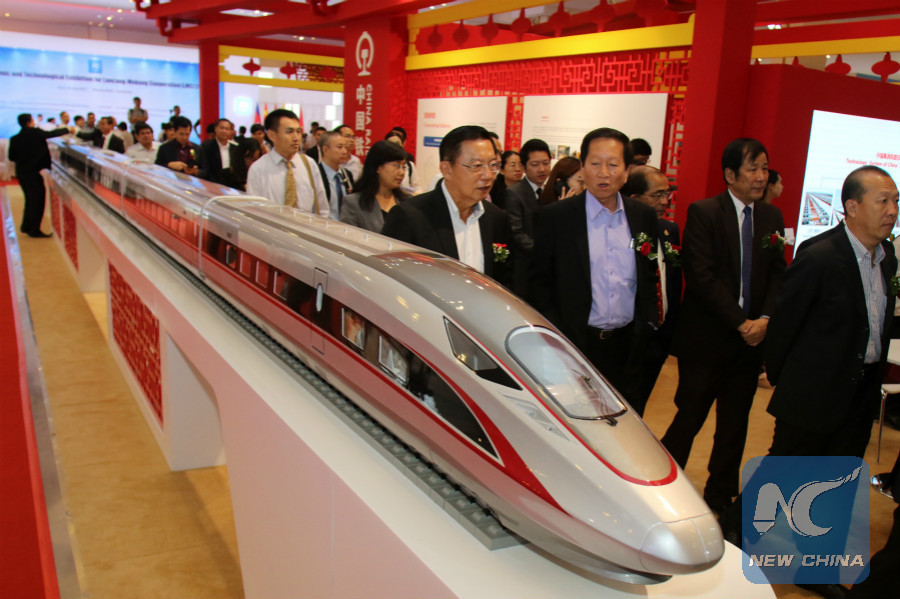
Visitors walk by a model of China's next generation bullet train "Fuxing" during the Economic and Technological Exhibition for Lancang-Mekong Cooperation in Phnom Penh, Cambodia on July 13, 2017. (Xinhua/Sovannara)
by Fei Liena, Lu Juan, Mao Pengfei
PHNOM PENH, Jan. 11 (Xinhua) -- The Second Lancang-Mekong Cooperation (LMC) Leaders' Meeting approved a Five-year Action Plan (2018-2022) here on late Wednesday, charting the course for the LMC's development into the next decade.
With a theme of "Our River of Peace and Sustainable Development," the meeting gathered leaders of China, Myanmar, Laos, Thailand, Cambodia and Vietnam to discuss such issues as connectivity, water management and industrial production capacity.
As an important mechanism along the Lancang-Mekong River sub-region, the LMC mechanism has been focusing on sustainable development and pragmatic cooperation in the sub-region and serving as an important platform for implementing the Belt and Road Initiative.
The Five-year Action Plan is the first of its kind since the establishment of the LMC mechanism, and will serve as a guideline for LMC's future development in the next five years.
According to the plan, by synergizing the China-proposed Belt and Road Initiative and the ASEAN Community Vision 2025 as well as the Master Plan on ASEAN Connectivity 2025 and visions of other Mekong sub-regional cooperation mechanisms, the LMC is moving towards a new sub-regional cooperation mechanism with unique features, which will support the ASEAN Community building and regional integration process, and promote the implementation of the UN 2030 Agenda for Sustainable Development.
The plan sets the years 2018 and 2019 to be the "foundation-laying" stage, when emphasis should be laid on strengthening sectorial cooperation planning and implementing small- and medium-sized cooperation projects.
The 2020-2022 period will be the consolidation and expansion stage, when member countries will further strengthen the cooperation in the five priority areas of connectivity, production capacity, cross-border economic cooperation, water resources, agriculture and poverty reduction, and may explore new cooperation areas.
Under the development goals and principles, the action plan sets guidelines for LMC member countries to cooperate in a wide range of areas including political and security, economy and sustainable development, social and cultural cooperation, and supporting system, with a view to "contributing to the economic and social development of sub-regional countries, enhancing well-being of the people, narrowing the development gap within the region and building a Community of Shared Future of Peace and Prosperity among Lancang-Mekong Countries."
Since its official launch in March 2016, the LMC mechanism has fast grown, with many fruitful results yielded, including a multi-layer cooperative mechanism ranging from the leaders' meeting to work groups. Most of the 45 Early Harvest Projects identified at the First LMC Leaders' Meeting and the 13 initiatives put forward by China have been completed or made substantial progress.
The LMC Special Fund set up by China is in full swing and will continue to offer financial support for 132 projects of LMC member countries. Two-thirds of China's concessional loans have been granted to the five Mekong countries for more than 20 infrastructure and industrial projects.
Lancang-Mekong Cooperation mechanism is like the engine of a high-speed train, pushing the cooperation between China and five Mekong countries into "the age of high-speed rail," Chinese Premier Li Keqiang said at the leaders' meeting.
According to Li, China is now the largest trading partner of Cambodia, Myanmar, Thailand and Vietnam, and the second largest trading partner of Laos. In 2017, the trade volume between China and the five Mekong countries reached 220 billion U.S. dollars, up 16 percent from 2016. China's total investment in the five countries has exceeded 42 billion U.S. dollars, with a growth rate of more than 20 percent in 2017.
The LMC mechanism has established a "3+5" mechanism of cooperation, referring to the three cooperation pillars, political and security issues, economic and sustainable development, and cultural and people-to-people exchanges, and the five key priority areas of connectivity, production capacity, cross-border economic cooperation, water resources, and agriculture and poverty reduction.
Premier Li suggested that, on the basis of the "3+5" mechanism, LMC member countries should expand cooperation in broader areas such as digital economy, environmental protection, customs and youth, to gradually form a cooperation framework of "3+5+X".
The first LMC leaders' meeting was held in Sanya of southern China's Hainan province in March 2016, at which the goal of building a community of shared future of peace and prosperity for the LMC countries was endorsed.
The Lancang River originates on the Qinghai-Tibet Plateau in southwestern China. It is called the Mekong River as it flows through Myanmar, Laos, Thailand, Cambodia and Vietnam before emptying into the sea.

